Except I wasn't entirely sure what a node was, let alone where to cut...
If your plant is a good candidate for water propagation (most of our indoor houseplants are), then this step-by-step how to guide is for you. One of the most popular indoor plant families that propagate really well in water are Aroids, that's plants like your Pothos, Epipremnum, Philodendron and Monstera, but there are lots more good candidates this method of node propagation in water works well for, including Syngonium, Hoyas, Chain of Hearts, String of Turtles, Begonias... the list goes on (and on).
And yes, there are also other ways to propagate, but water propagation is the simplest way to start if you're new to propagating plants, or simply want to speed up the process, as cuttings root faster in water vs soil, plus you can easily see what's going on each step of the way. It's VERY satisfying watching those roots grow :)

Some links are Amazon affiliate links, which means I may receive a commission for purchases made through links but it doesn't change the price you pay. Learn more
Step 1: Know your plant's bits (and find the nodes)
The main planty parts you'll be looking for are the nodes, which I've marked on my Pothos N'Joy below. You can see the nodes are located at each junction where the petiole and leaf grow out of the main stem. On a lot of plants the node is easy to identify as a raised ring around the stem.
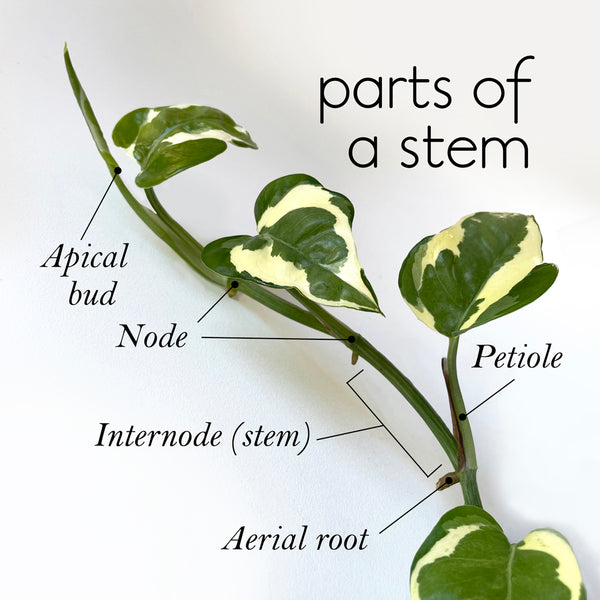
You'll sometimes see little nubby aerial roots beside the nodes also (or in the case of some plants like Monstera, they can be monster aerial roots). Here's my Neon Pothos below, also showing you the nodes and aerial roots. This plant is going to be our guinea pig for today's tutorial on where to cut...
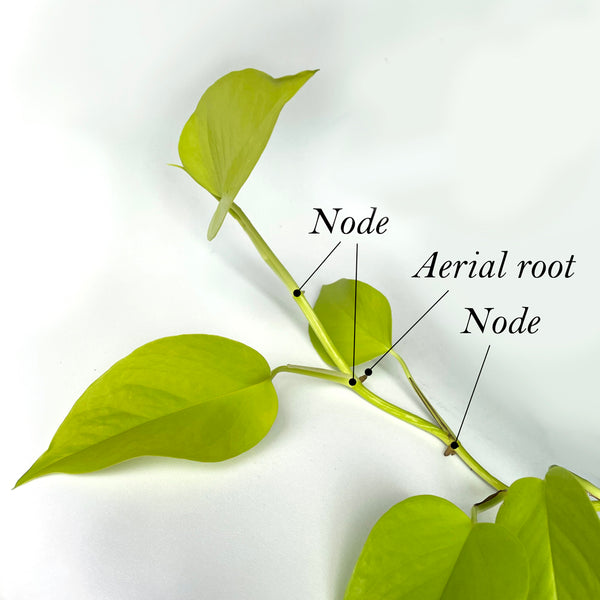
Step 2: Cut below a node
Using this method, I like to have at least two nodes and two leaves on each cutting, but you can propagate with less or more. Too many leaves on a cutting however can slow things down and reduce the chance of success. You can even propagate from a 'wet stick' (a stem with a node but no leaves). Once you've located a node, it's time to get the snips out. Make sure you're using sharp, clean snips so you don't pass any fungal disease, pests or other diseases between plants.
TOOL TIP What are the best snips for taking indoor plant cuttings?
The best budget-friendly snips are these Crew Mini Snips when you want to save your pennies for your plants. Or for those not in NZ, the Ryalan Small Snips are the same and available from Amazon. But I have to admit I'm slightly obsessed with my Japanese Hidehisa House Plant Shears. I use them any chance I get (that's if your budget allows you to invest in something really special for you and your plants).
PRO TIP for propagation: Cut stems on an angle
I cut stems on a roughly 45 degree angle, but the exact angle doesn't matter, as long as it's not straight. The idea behind cutting the stem on an angle vs straight is to find a balance between disease, water and roots. Cutting straight reduces disease because cuttings seal faster, but cutting on an angle is meant to help increase root development. Of course we're putting roots first, that's sort-of the point, so I always cut on an angle, but there's another easy way to protect from disease coming up in step 4 below.
Where to cut when propagating...
When you're ready, simply snip the stem on an angle just below a node, ideally below a node that already includes an aerial root. You can work your way down a stem and get multiple cuttings by repeating this same step below every node, or below every second node, making sure to include leaves.
Here's where you could cut this one, or you could shift down the stem a bit, and cut below one node further down instead to give you two nodes in the water. The key thing is to cut below a node but still keep a few leaves...
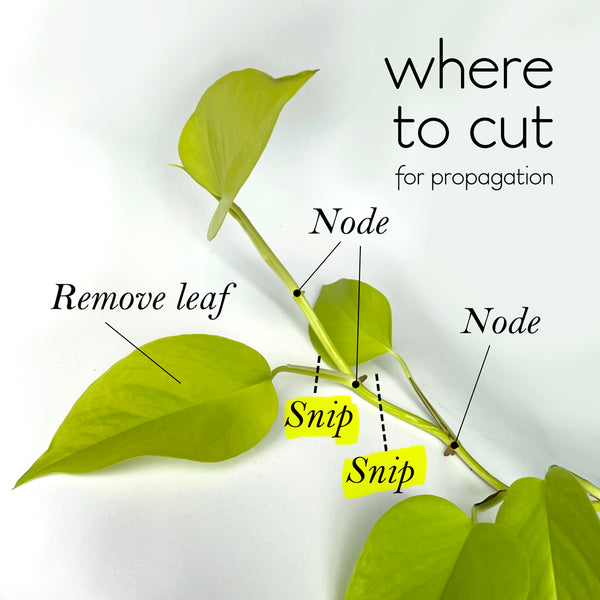
Why include an aerial root?
Aerial roots, water roots and soil roots are all roots, just with different adaptations according to what they grow in. They can absorb water and nutrients, so including an aerial root in your cutting will help the cutting survive while those new roots grow.
Step 3: Remove extra leaves
Keep the top leaves on your cutting - the roots need them for enough photosynthesis to fuel that new root growth - but do remove the bottom leaves near the node that's going in the water, so the leaves don't end up rotting in the water.
You also don't want too many leaves on your cutting, as without roots the plants can't support lots of leaves for long. On most indoor plants, the nodes are where the new roots are going to grow from. This should mean you end up with cuttings that look a bit like this, below (after you've trimmed off the leaves by the bottom node)...

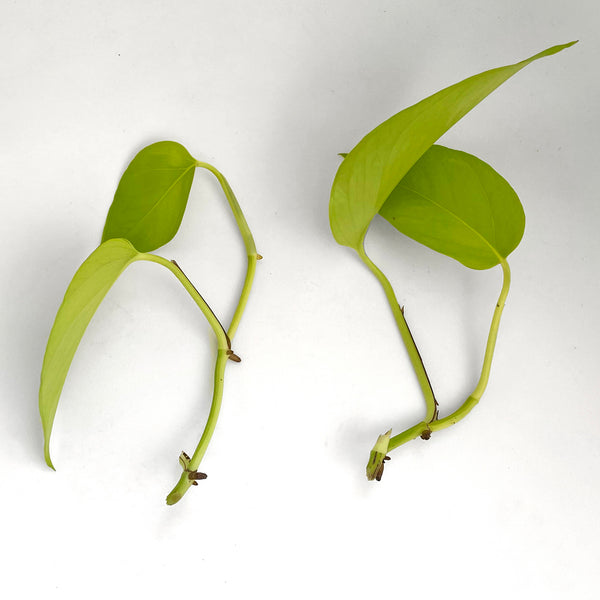
Step 4: Dip in rooting hormone
This is a step you don't have to do, but I definitely recommend it. If you're going to cut off that lovely growth tip you might as well do everything you can to make sure it actually roots not rots!
There are a few rooting hormone pastes, powders and gels on the market. My favourite hands-down is GT Clonex (that's the link to get GT Clonex in New Zealand, which is also marketed under the Yates brand, called Yates Clonex which GT makes for Yates). Or if you're not NZ-based, you can get Clonex here from Amazon.
Clonex is in a gel form. If you prefer a powdered cloning paste, an NZ option is Egmont IBAdex or on Amazon, Bontone Rooting Powder uses the same source of rooting hormone, IBA. Why I prefer Clonex is because it's not just a source of rooting hormones, but is also antifungal, so helps prevent rot while also speeding up the time until a cutting roots.
Dip the bottom 1.5cms of the stem of your fresh cutting in the power or gel. Tap off the extra before putting your cutting in water (or soil or spag moss or your substrate of choice).
Step 5: Put in water
Time to bring out one of your gorgeous propagation vases you've had plans for. Although pretty much any vessel will do that keeps leaves out and the stem submerged in water. Wide-top vessels like jars, mugs and glasses can be a problem keeping the node in the water and leaves out of the water, so the clever Claroplants propagation plants take care of that problem.
As much as I love those adorable test tube propagation stations, I don't love the constant need to top up the water (that particular one linked does at least have a bigger capacity than most). A few times I've realised the water level's dropped too low, too late, and a cutting's dried out along with it's precious new roots. Oops. I also prefer a bit more room for roots than test tubes provide. I prefer a medium sized vessel for my cuttings, where the water level doesn't drop as fast due to evaporation, and roots have extra room to grow.
Whatever size your vessel, a good tip is to put them in an area you go every day, like by the kitchen sink, so you can keep an eye on that water level. Find a spot that's warm and bright. Both help those new roots grow, but warmth is a biggie for new growth, more than light at first.
So much so, that if you're propagating in winter or in cooler temperatures, definitely get yourself a heat pad to trigger root growth. I use the Inkbird heat mats for mine (you can get the same Inkbird Heat Mat here on Amazon if you're overseas). Avoid direct sunlight as it can burn the leaves (one reason a windowsill might not be the best idea).
Here's one of those Neon Pothos cuttings from earlier, below. Snipped, dipped in Clonex, in water and ready to get those roots growing. This cutting ended up with 3 nodes and 2 leaves. You can see one node above the water, and two nodes below (I like having 2 nodes in water when I can as it increases the number of roots)...
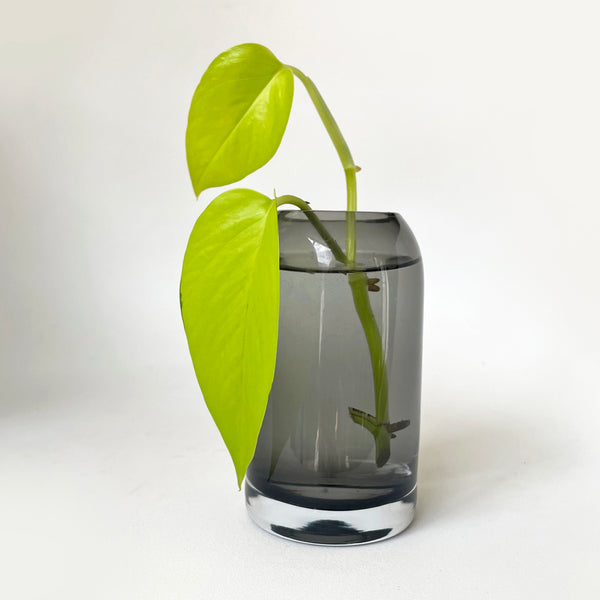
Step 6: Feed
There are 12 essential nutrients plants need that they can't get from light and water alone. At first, the extra boost from Clonex should be plenty, but once roots start growing, it's time to start providing the nutrients needed to grow more, stronger roots, faster and get that foliage started. Start feeding as soon as you notice the first root growing.
There are lots of fertilisers suitable for water propagation. My favourite is called GT CCS, made by the same company who make Clonex. You can get CCS from Amazon also. It's a complete root fertiliser, gentle enough for cuttings and seedlings, and also formulated for use in water, not just in soil.
Step 7: Change the water
You want to change the water in your propagation vessel at least once a week or at least top it up with fresh water. You can top it up to keep up with evaporation, but fresh water about once a week helps replenish oxygen and nutrients for the roots. That's also the time to add root fertiliser (like GT CCS, linked above), as well to keep those essential nutrients up for healthy, strong roots.
Step 8: Remove from water
Once your cutting has some nice healthy water roots underway (see below for how long roots should be before you pot up your cuttings), it's time to remove them from water, and pot them up in substrate.
You can stay growing in water, but if you do plan to move to soil or another substrate at some stage, then don't leave them too long in water. Left too long, those delicate water roots have a harder time transitioning to bigger, tougher soil roots, and you could lose your new plant after all your patience. Here's the difference between soil roots and water roots and how to prevent them rotting >
An ideal time for your cutting to graduate from water to soil, is when the main root reaches around 3cm to 5cms long, or an even better sign, is when the main root starts to branch and send out side roots. Some don't branch for some time, and the main root just gets longer and longer so use the length as your guide for when it's ready.
Here are a few rooted cuttings below, all ready to pot up. You can see how the roots have grown from the nodes on each one. The cutting on the left has started to branch, the roots on the middle cutting have been left a little longer than you'd need to, so definitely ready to pot up, and on the right you can see roots of an ideal length, and roots growing from two nodes on that cutting.
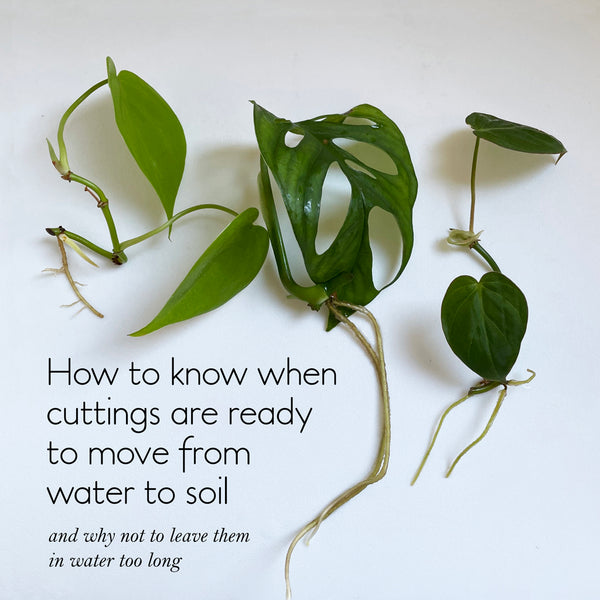
How long does it take for cuttings to root in water?
A few factors come into play with how long it might take before you start to see roots. Some plants produce roots super fast, within a week or two, some take 4 to 6 weeks or longer. Heat and light both help with warmth being a key factor (which is why propagating in winter is more difficult), and a rooting hormone like Clonex definitely speeds everything up.
Until the first root appears, there's no need to fertilise at first. Give your cuttings the ideal conditions, and a little boost from rooting hormone, and you should have roots in no time. Before you know it you'll be admiring your new baby plant, created by you!
The end!
You made it! I hope you feel more confident now about giving it a go yourself, or found out a few tips and tricks to help you through the 10 stages of plant parenthood. If this guide helped you, please pay it forward and share it with another planty parent :)
